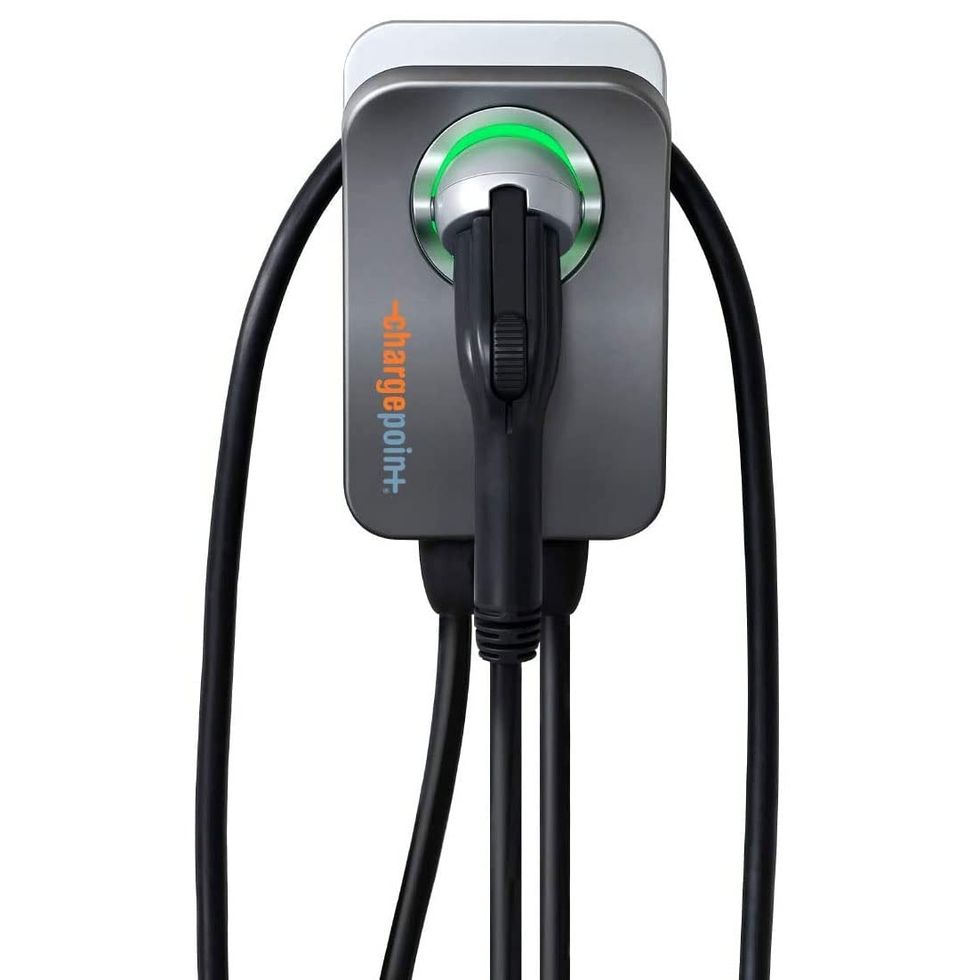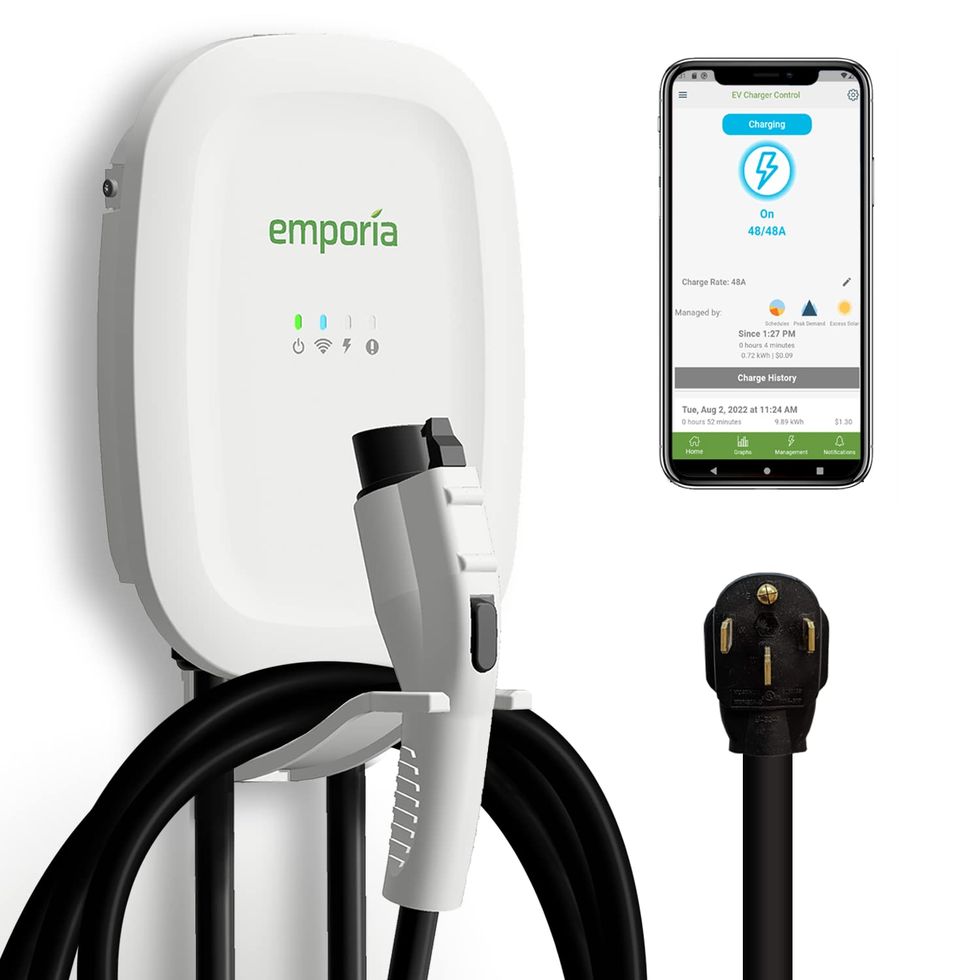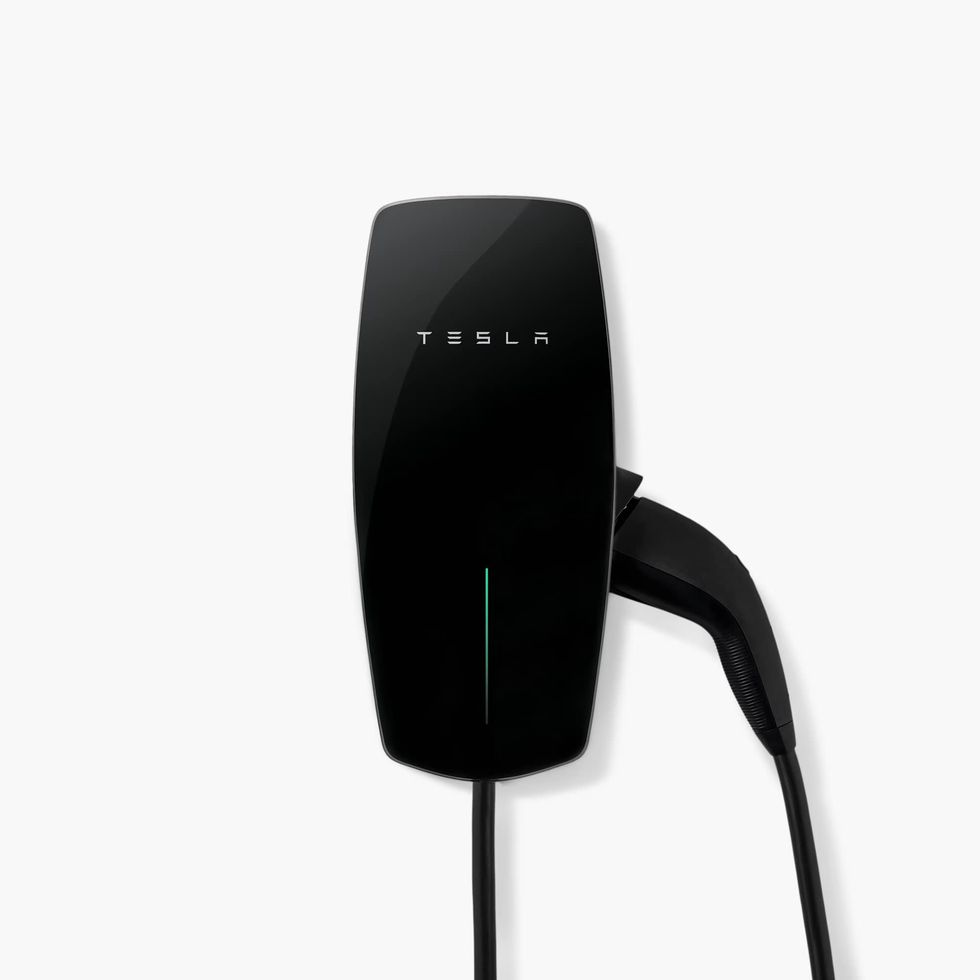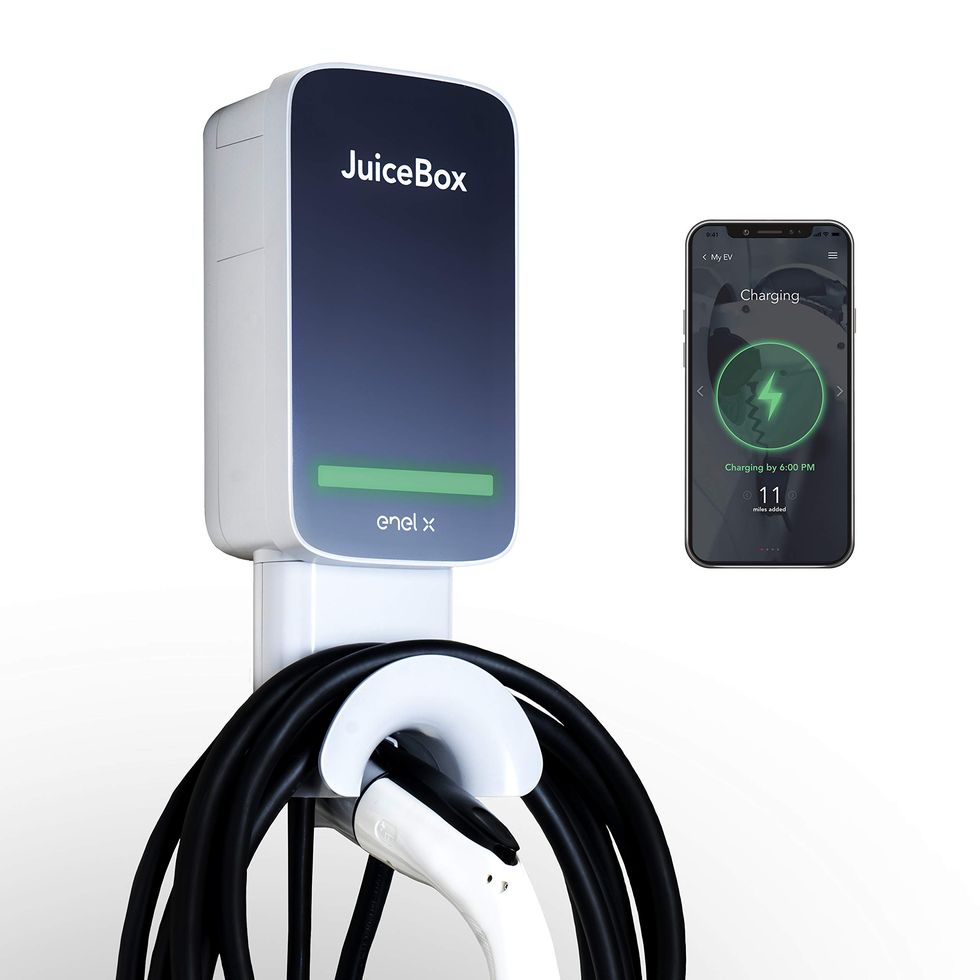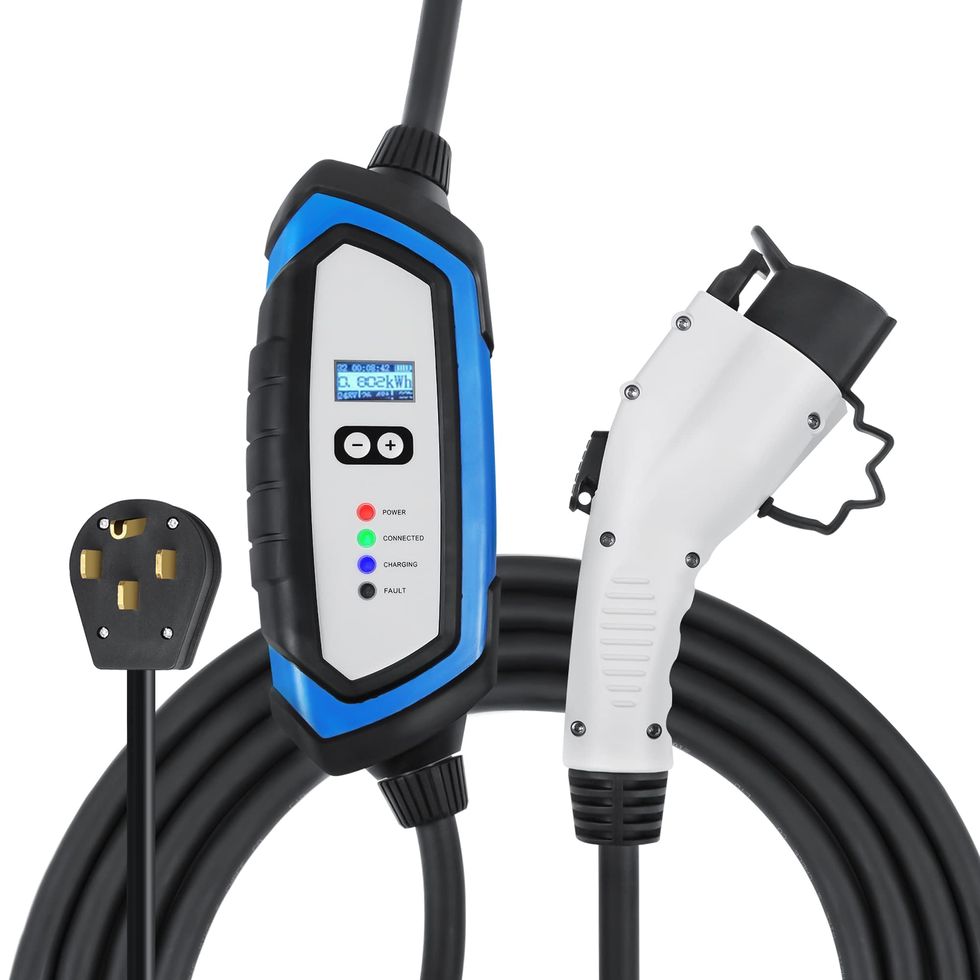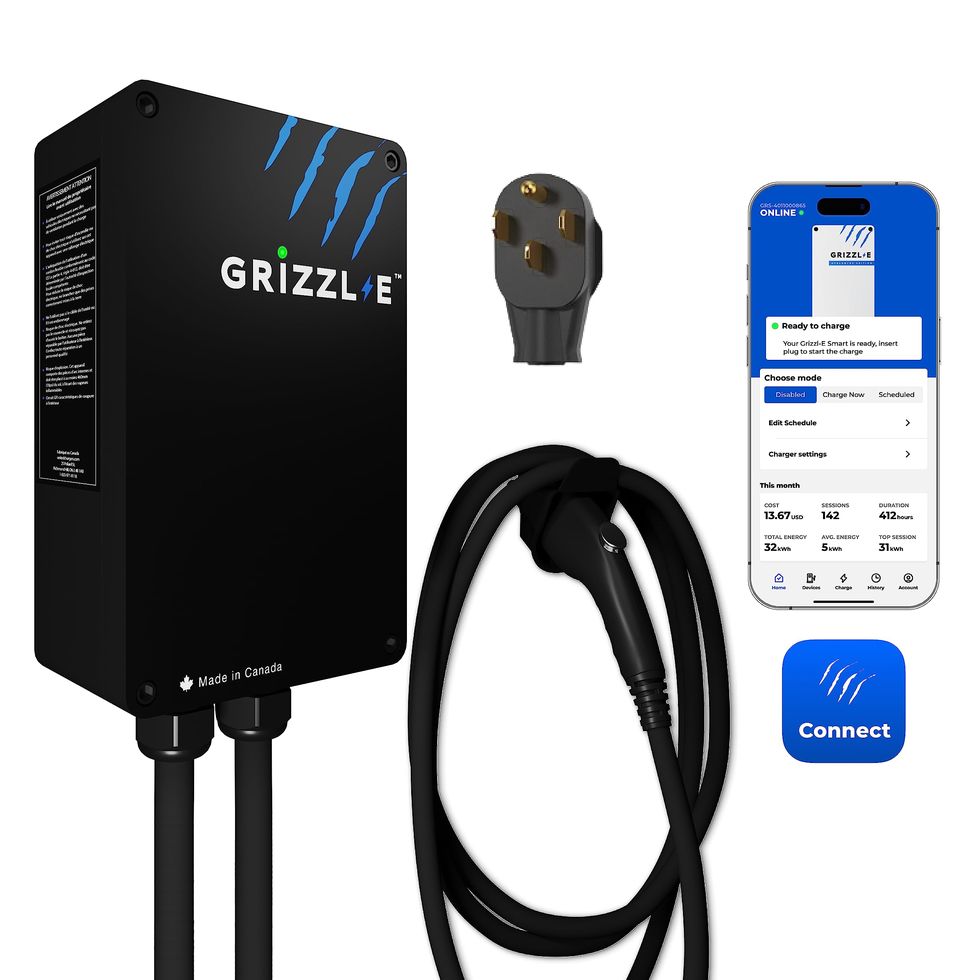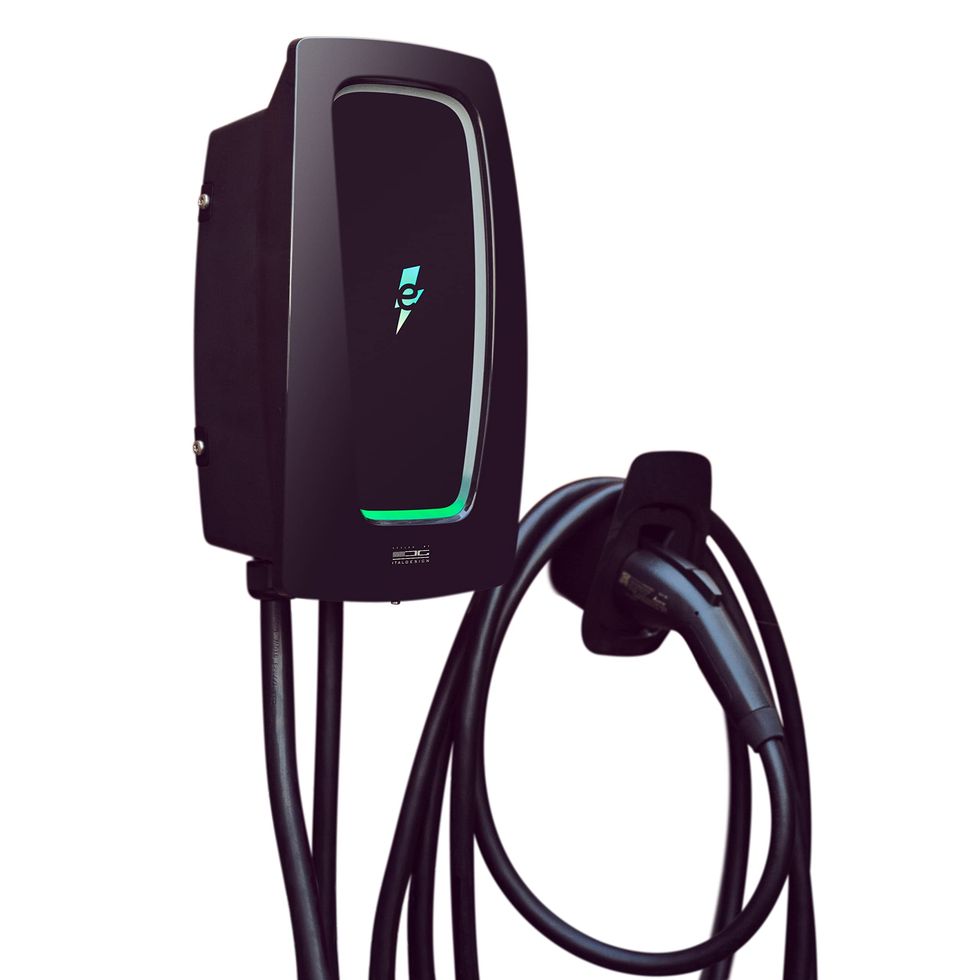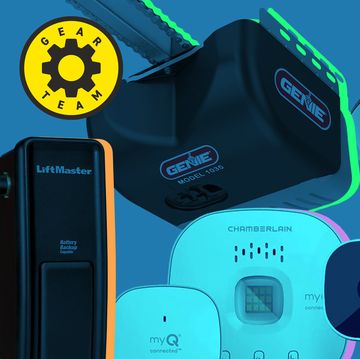Our car experts choose every product we feature. We may earn money from the links on this page.
Experts Tested 7 Home EV Chargers to Find the Best
In the market for an electric vehicle charger? You can't really go wrong with any of these electric car charging options.
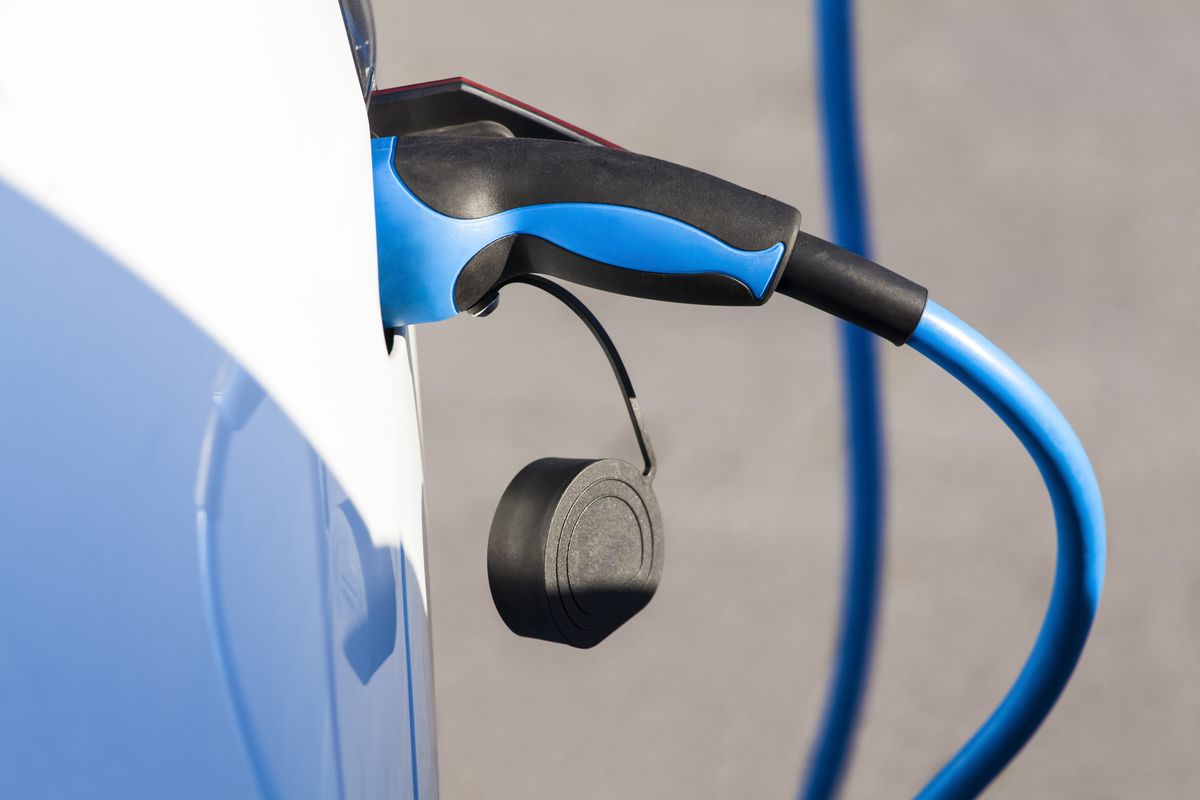
This article was updated with new products and information in July 2023. We plan to update this piece as needed, so check back regularly.
The age of the electric vehicle is drawing nearer. As legislation from across the globe continues to push automakers towards EV exclusivity, there is a higher chance than ever that you might be considering installing an EV charger in your garage. Whether you’re an excited early adopter or a begrudging buyer, one thing is certain: you’re going to need a way to charge that battery-powered automobile.
The Hearst Autos Gear Team tested a wide range of different options at various price points, in an effort to discover the best home EV chargers available in 2023.
Our Top Picks
Things to Consider When Shopping for a Home EV Charger
There are three major factors to consider when considering a home EV charger: the output of the household circuit you're connecting to, the output of the EV charging equipment, and the rate of charging that your vehicle can handle.
We've gathered seven charging options to connect your house to your electric car that range in price from $300 to $700, all of which are compatible with any new EV on sale today. The more expensive ones tend to have Wi-Fi connectivity, which lets you monitor charging, receive alerts, and control the unit via an app. Many of these products have variants (hard-wired or plug, different output capabilities, and varying cord lengths) with slightly different prices.
Pros
Intuitive and easy-to-use app
Built-in notch at the top of the unit for cord management
Cons
One of the most expensive
- Output capability: 50/48/40/32/24/16 amps (12.0/11.5/9.6/7.7/5.8/3.8 kW)
- Cord length: 23 feet
- Cord management: Built-in
- Outdoor rating: Yes (NEMA 3R)
ChargePoint's Home Flex unit integrates into the same app used to connect to the company's vast public charging network. Functions in the excellent app include the ability to schedule charging times at efficient off-peak hours, nuanced cost tracking, and a percentage of the battery replenished paired with the number of EPA miles added to your ride.
Overall, the app is very user-friendly and adequately displays helpful charts for charge-rate graphs, total energy output, and total charge time during each charge. The design of the dock is clever as well; ChargePoint included a notch at the top to aid with cord management. Most other brands require the purchase of a second cord-management device.
Pros
Comparatively high output
Price won't break the bank
Cons
App is a bit messy
- Output capability: 48–6 amps (11.5–1.4 kW)
- Cord length: 24 feet
- Cord management: Included wall mount
- Outdoor rating: Yes (NEMA 4)
The Emporia electricity-monitoring universe is a bit like a double-edged sword. They offer a wide range of smart devices and tools to keep track of electricity—which can all be accessed through their app. But if you're just using the EV charging equipment, navigating around all of these unused areas makes the app seem far too complicated.
Otherwise, this Wi-Fi-connected entry option impressed the Gear Team; coming in at a price that's hundreds of dollars less than the JuiceBox or ChargePoint. The 11.5-kW output capability is at the high end of this roundup, and short of a couple key features, the Emporia has just about everything.
Pros
Easy setup at a reasonable price
Can charge more than just Teslas
Cons
Might need an adapter to connect to non-Teslas
- Output capability: 48/40/32/24/16/12 amps (11.5/9.6/7.7/5.8/3.8/2.9 kW)
- Cord length: 24 feet
- Cord management: Built-in
- Outdoor rating: Yes (NEMA 3R)
Don't let the brand name fool you—ownership of a Tesla isn't needed for their Wall Connector. While it comes with Tesla's NACS plug, they also offer the common J1772 plug as an option; you just need to get an adapter.
The sharp-looking Wall Connector also has Wi-Fi capability for firmware updates but lacks the ability to control or monitor charging—something that's important to many owners. However, Tesla owners can see that info via the TeslaFi info hub.
The setup is straightforward; simply scan the QR code on the side of the unit to connect to Wi-Fi. Output is then controlled through a web-based interface. The Wall Connector is also capable of nearly the highest output in this test, and the cables are nice and flexible.
Pros
Can be controlled and monitored remotely
Different output versions offered
Cons
No energy cost tracking
- Output capability: 40/32/24/16/12/6 amps (9.6/7.7/5.8/3.8/2.9/1.4 kW)
- Cord length: 25 feet
- Cord management: Built-in
- Outdoor rating: Yes (NEMA 4X/IP66)
When Car and Driver first tested home EV charging units in 2022, the Gear Team preferred the JuiceBox charger to all the rest. However, JuiceBox has since revamped its app—but for the worse. The Gear Team found it much more annoying to use. Nevertheless, the JuiceBox is still one of the most feature-rich Wi-Fi-enabled Level 2 chargers.
The JuiceBox offers three output levels, depending on your home's circuit: a cheaper 32-amp option, the 40-amp option tested here, and a more expensive 48-amp version.
The JuiceBox provides energy output and charge time for each charging session, various adjustable notifications, and the ability to set up customized charge times to take advantage of differing electricity pricing.
Pros
Cheapest charger tested
Allows for energy tracking
Cons
Not Wi-Fi enabled
- Output capability: 32/16/13/10 amps (7.7/3.8/3.1/2.4 kW)
- Cord length: 21 feet
- Cord management: none
- Outdoor rating: Yes (IP67)
While the Lectron is one of the most budget-friendly options, there are some drawbacks. Notably, the lack of any sort of wall mount. A hook from your local hardware store will suffice, but that's inconvenient.
While this charger is not Wi-Fi enabled, it does feature a small LCD screen that displays, charge time, energy (kWh), voltage, amperage, and temperature.
The unit can set the limit on current, which can be adjusted among 10, 13, 16, or 32 amps of output to match your wall circuit. When you plug in, charge time starts over, but the kilowatt-hour readout doesn't, so if you want to monitor individual charges to track your car's efficiency, you have to unplug and replug before every charge. This can get tedious, so if you want to track your charging fastidiously, one of the Wi-Fi-connected units is probably a better choice.
Pros
Budget-friendly smart option
Cons
App is finickey
Thick cable is hard to manage
- Output capability: 40/32/24/16 amps (9.6/7.7/5.8/3.8 kW)
- Cord length: 24 feet
- Cord management: Included wall mount
- Outdoor rating: Yes (NEMA 4X/IP67)
In a reflection of its name, the Grizzl-E embraces durability; touting the ruggedness of its beefy aluminum enclosure, with videos on its website showing a small off-road vehicle running over it (which seems completely unnecessary for a thing that's mounted on a wall in or outside your garage). The cables are also rugged, but the most difficult to hang up.
Theoretically, the Grizzl-E Smart can pair with any EV charging app that uses the OCPP (Open Charge Point Protocol) 1.6 and it's one of the cheapest smart units. Unfortunately, it took the Gear Team months to get theirs to connect. Thankfully, Grizzl-E has since streamlined the connection process.
Like the other units, this one can adjust among various output levels, but that's most difficult to accomplish in the Grizzl-E. Rather than change it via the app, you have to take off the front cover to toggle DIP switches and also reset the Wi-Fi connection.
Pros
Integrates with the Electrify America app many EV owners likely already have
Cons
Bulky
Stopped communicating with the app after one charge
- Output capability: 40/32/16 amps (9.6/7.7/3.8 kW)
- Cord length: 24 feet
- Cord management: Included wall mount
- Outdoor rating: Yes (NEMA 3R)
This Electrify America home charging station also uses the same app for their public fast chargers. Thankfully, most EV owners are familiar with this and have the app already downloaded. Simplicity is the name of the game with this unit: scan a barcode to add it to your account, and connect it to Wi-Fi.
Weirdly, this unit is very bulky, and the short power cable limits mounting options. In addition to this annoyance, the Gear Team's unit stopped communicating with the app after the first charge. They finagled with support for a while and didn't hear back via emails either—making Electrify America's customer service essentially nill.
How The Gear Team Tested Home EV Chargers
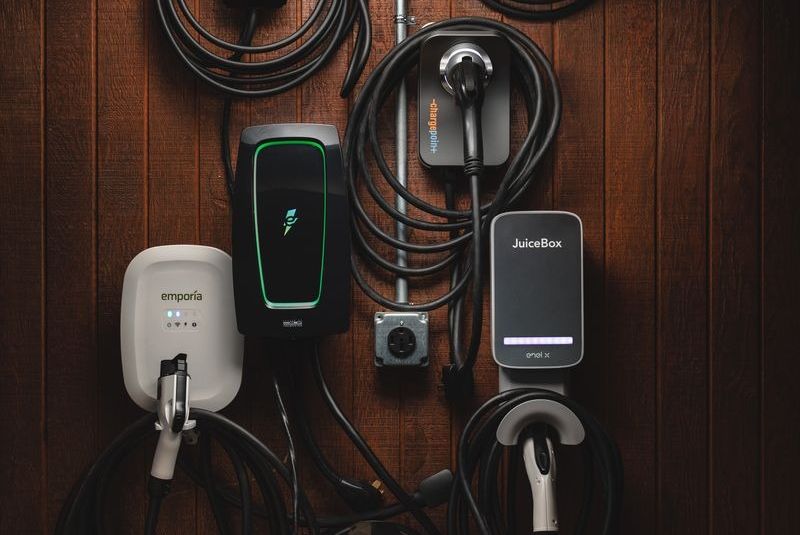
When putting together this story, Dave went down the same path a new EV owner would, starting with installing a dedicated 240-volt outlet in my garage. The Gear Team has a charger at the office, but they needed a proper setup at home to support all of the EVs we're reviewing these days. They were able to add a 40-amp circuit to the existing electric service in my house without a pricey upgrade to run additional capacity, so that's why they landed on a 40-amp outlet versus a 50-amp setup. To be able to easily switch among the units, they ordered the NEMA 14-50 plug-in variant of each charging device. (Note: Tesla doesn't sell a version of its Wall Connector with a plug, so to keep the Gear Team test comparable, they wired one in themselves to connect to their NEMA 14-50 outlet.)
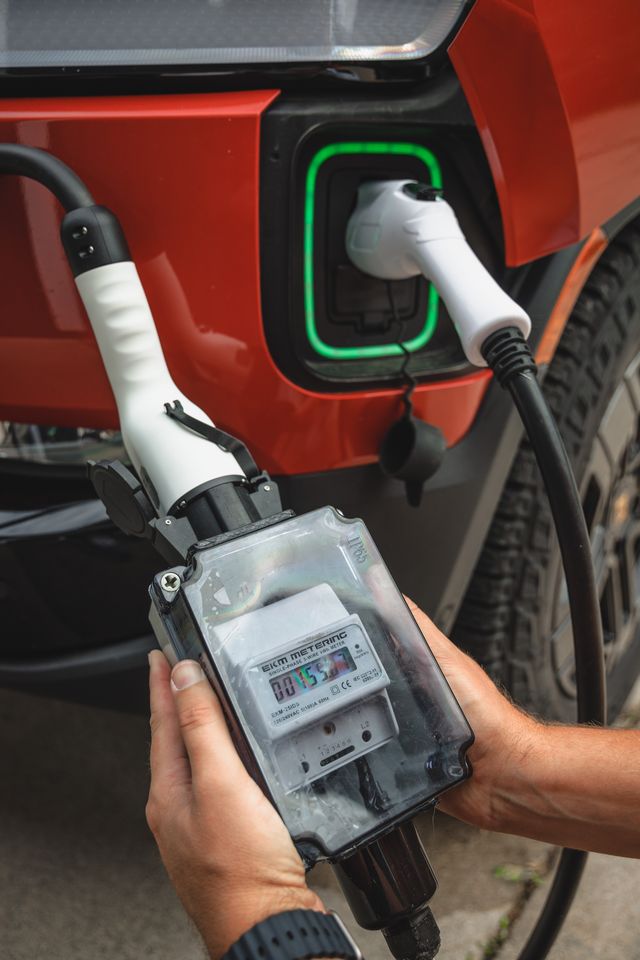
In the first round of testing, the Gear Team used each unit to charge a Tesla Model 3 numerous times over a period of months. They then compared the electricity output from the wall to what the Model 3 reported made it into its battery pack using the third-party (and very cool) TeslaFi software. Recently, they tested a few new units along with their favorites from before using a Rivian R1T, verifying the energy delivered to the vehicle via an inline electrical meter. Despite varying cord lengths and thicknesses, there was no measurable difference in performance or efficiency (which averaged roughly 5 to 8 percent charging losses).
FAQs
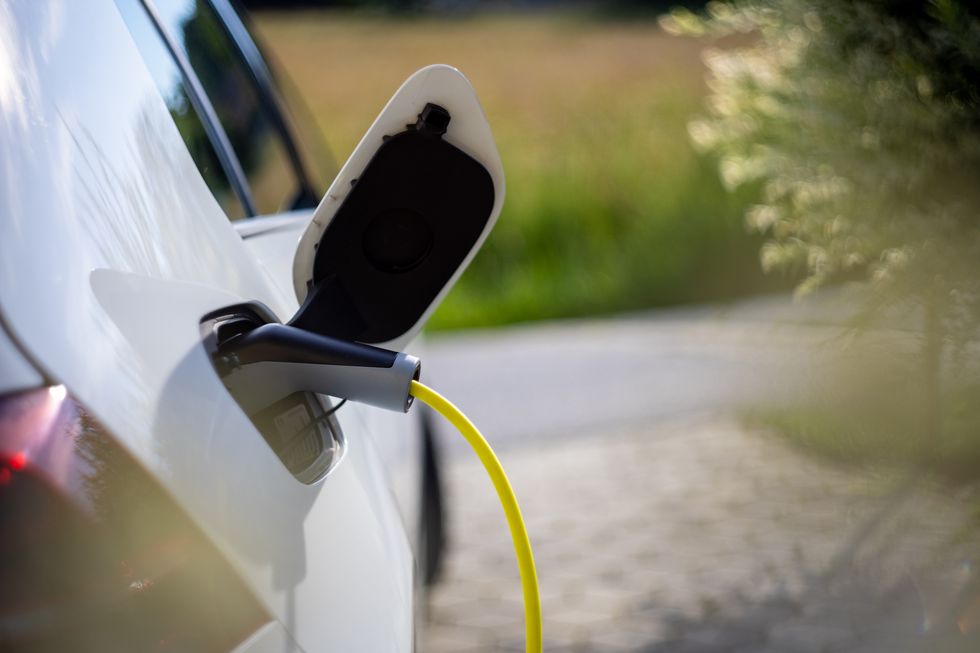
What are the different types of EV chargers?
Before you charge your electric vehicle, it is helpful to know what sort of options you have at your disposal. There are three main types of chargers, each with different performance levels on offer: Level 1 and Level 2 AC chargers, as well as Level 3 DC fast chargers. When it comes to at-home units, Level 1 and Level 2 offerings are by far the most common option. This is mostly due to the fact that your home is already running on an AC electrical circuit, and therefore these chargers don’t require special equipment or specialized help from your service provided during installation.
Level 1 chargers run on 120-volt AC current, and can be plugged right into a typical wall outlet. As you’d expect, this is the slowest way to recharge your EV. Speeds typically sit right around 4 kilowatts. Level 2 chargers on the other hand operate on 240-volt AC current.
While you might not think you have one of these plugs accessible in your home, chances are your dryer already operates on a 240-volt outlet. Depending on the amperage of your socket, you can expect speeds between 5.8 and 19.2 kW. Level 3 chargers are extremely high-voltage (400 to 800 volts), and are completely incompatible with the wiring in your home. They also tend to run deep into the six-figures, which is why you'll really only find these at public charging stations.
They're also capable of pilling the miles back into your battery with haste, with Tesla's Supercharger network delivering around 200 miles of range in just 15 minutes of charge time. Based on the amount of driving that you do, as well as your public charging options, either a Level 1 or Level 2 charger will be a great addition to your garage regardless.
Are all home electric vehicle chargers the same?
This one really depends on how technical you want to be. The tools that we call EV chargers are really known as electric vehicle supply equipment, and simply serve to transfer energy from your home into a vehicle. From there, the vehicle’s onboard charger will turn that AC current into some DC flow, which it uses to charge up the battery pack. In that sense, the overall function of every home EV charger is identical. That said, there are certainly some real-world differences in how these machines operate, as well as the features they provide owners.
The biggest difference between home charging options is going to come down to the overall output of the charger. These figures are measured in either amps (e.g., 32, 40, 48 amps) or power (e.g., 7.7, 9.6, 11.5 kW). The higher the output of the charger, the faster you will be able to charge.
The second major factor to consider when shopping relates to whether or not you’d like a smart charger. Backed by wi-fi connectivity, these chargers tend to offer more features such as charge reports, scheduling features for off-peak charging, and even mileage logs. Those added features tend to bring an added lump to the price tag, so it’s worth considering your actual use case.
How to choose the right charger?
Here are some of the major considerations that should go into every EV home charger purchase:
Cable Management and Length
It may seem silly, but having a convenient place to stick your charge cable after a top up is a nice feature, and one that many chargers lack. Of course you can always stick a hook in the wall should your charger of choice lack this option. What's harder to work around is the length of the charging cord, which varies dramatically between manufacturers. Depending on where you park and the overall cleanliness of your garage, a long cord might be a necessary. Furthermore, thick cords aren't as flexible as skinnier counterparts, but they are more likely to stand up to some abuse. Keep all of these factors in mind while you shop
Size
Depending on how much space you have available in your garage or outside your home, certain EV home chargers just might not fit your needs. A bulkier unit could eat up useful garage space, whereas a thinner unit would not. Measure the space in which you'd like to place the charger, and make sure the unit you intend to purchase will fit!
Weatherproof
If you're limited on garage space, you may opt to install an outdoor EV charger. While there are a ton of weatherproof units available for purchase (including every unit you see here), double check the owner's manual to ensure everything is up to par. Water and electricity is not a fun combination.
Hardwire Vs Plug-in
Once you've got a space set aside for you home EV charger, you'll need to decide whether you want a hardwired or plug-in unit. Plug-in units have gotten far more popular as more EVs hit the market, as owners can simply unplug the unit and bring them along on trips or a full-blown move. That said, a hardwired unit will still provide the same level of charging performance, albeit locked into one place.
Do I need to buy my own EV charging equipment?
This is a more personal consideration that every EV must make. You technically don't need any form of home charger to own an EV, as a typical wall outlet is capable of juicing up a car's battery pack if needed. As we've previously discussed however, that simple outlet isn't packing a ton of output behind it. If you don't drive all that much, you might be more than fine simply topping up a little bit each night, and hitting the public charger when possible. That said, people who have to do a bit more mileage might want to consider some of the home charging options you see here.
How do I wire my house to charge an EV, and how much does it cost?
The answer to this question is largely dependent on the home that you are currently living in. If you have enough electrical capacity on your property, an installation can be as low as a few hundred dollars, as you'll just need an additional dedicated electrical line.
This runs from your breaker right to the charger and ensures you have the consistent output required to charge the vehicle. You're also going to need a 40- or 50-amp circuit installed if you don't have one nearby. A NEMA 14-50 outlet; outlet works great, and allows you to unplug your charger if needed. You can also run heavy power tools on that outlet, should you have a project car in the garage as well. Qmerit is a company that provides these installation services nationwide, and is a great resource for new EV owners.
If you don't currently have enough electricity available on your property, the cost of installing a charger gets significantly more expensive. We're talking at least a few thousand dollars worth of work in order to bring you the extra juice. That's worth keeping in mind before you start tackling an EV charger install on your own.
Are there tax breaks for electric car owners who buy a home charger?
Yes. The sweeping Inflation Reduction Act reinstated a federal tax credit of 30 percent of your total costs (capped at $1000). That includes money spent on electrical upgrades and wiring to your house, in addition to the charging unit itself. This credit is currently set to be in place through 2032. In addition, there are often additional state or regional incentives, so make sure to check what's available in your area.
Which plug type should I choose for my charging equipment?
Although several automakers have announced a switch from a J1772 connector to Tesla's North America Charging Standard (NACS) design in the 2025 time frame, whether you buy a J1772 or NACS unit today doesn't limit its future compatibility. There are adapters to go from NACS to J1772 or vice versa, and with the mixed ports both on the vehicles and the public-charging infrastructure, EV owners will need to get used to keeping adapters in their vehicles to be prepared for whichever plug type they encounter.
Can charging equipment be mounted outside?
Generally, yes. Each charging unit they tested has an outdoor-grade rating according to either the National Electrical Manufacturers Association (NEMA) or Ingress Protection (IP) standards. A NEMA 3R rating, like the ChargePoint and Tesla Wall Connector have, is intended for outdoor use, but does not mean watertight; under certain circumstances, moisture could potentially enter the enclosure. The NEMA 4X rating of the JuiceBox 40 and Grizzl-E is superior. The IP ratings are two digits, the first representing the unit's resistance to solids (in this case dust) and the second number representing water protection. An IP66 rating means the unit is intended for outdoor use, with complete protection from dust or high-pressure water. But an IP67 goes one step further and can be immersed in water up to three feet deep.
Another thing to keep in mind with charging equipment mounted outside is that the electrical feed line to that location must also be in an outdoor-rated enclosure and, if you’re using a plug-type unit like they tested, that the outlet's enclosure must also be rated for outdoor use.
What's the difference between a vehicle's onboard charger and an EV charger?
Although many people refer to the products reviewed here as "chargers," technically they are electric-vehicle supply equipment, or EVSE. The vehicle's onboard charger is a device that converts the AC electricity from your house to DC energy to be stored in the battery, and it determines the fastest Level 2 charging rate your vehicle can handle. No matter how much electrical output you have at your house, you can't exceed the charge rate limited by the onboard charger.
Why Trust Us
Road & Track and its sibling publications at Hearst Autos represent three of the most influential automotive publications in the world. We rely on decades of experience in the automotive and gear spaces to help readers make informed purchasing choices.
With the legacies of Autoweek, Car and Driver, and Road & Track behind us, the Hearst Autos Gear Team is more concerned with our integrity and the trust our readers place in us than our bottom line. We won't tell you to buy something if we wouldn't buy it ourselves or recommend it to our friends, and we'll never claim to have used or tested something if we haven't.
We've evaluated dozens of products, from SIM Racing Setups and Rooftop Cargo Carriers to Affordable Watches. Our picks and recommendations of products and gear are based on testing and knowledge, not hype.

Born and raised in Metro Detroit, associate editor Lucas Bell has spent his entire life surrounded by the automotive industry. He may daily drive an aging Mustang, but his Porsche 944 and NB Miata both take up most of his free time.
Dave VanderWerp has spent more than 20 years in the automotive industry, in varied roles from engineering to product consulting, and now leading Car and Driver's vehicle-testing efforts. Dave got his very lucky start at C/D by happening to submit an unsolicited resume at just the right time to land a part-time road warrior job when he was a student at the University of Michigan, where he immediately became enthralled with the world of automotive journalism.
Watch Next

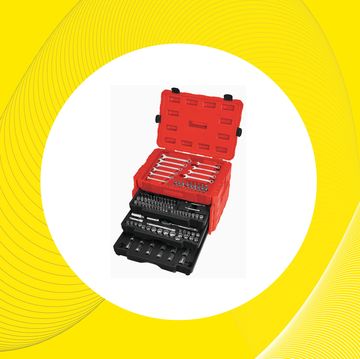
Deal Alert: Complete Mechanics Tool Set 41% Off

Gift Ideas for Car-Loving Dads

Auto Gift Cards Make the Best Father's Day Present

Father's Day Gift Guide for Car-Loving Dads
